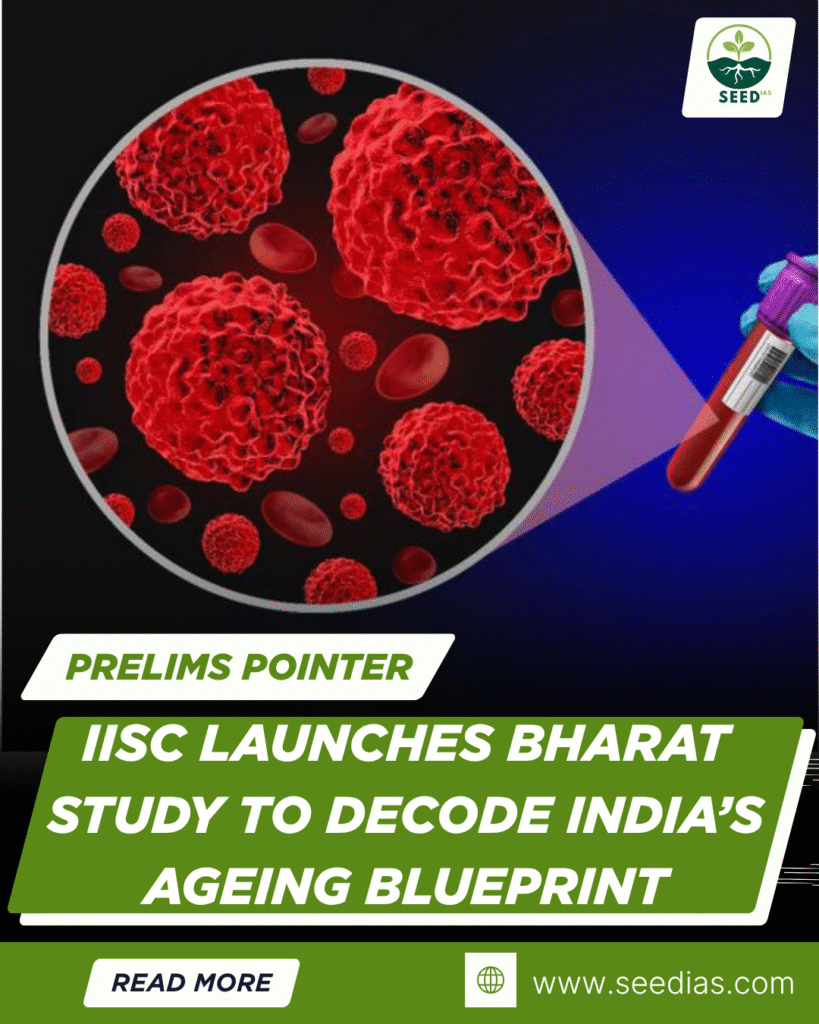Why in NEWS
The Indian Institute of Science (IISc), under the Longevity India Programme, has launched the BHARAT Study (Biomarkers of Healthy Aging, Resilience, Adversity, and Transitions) to establish India-specific biomarkers of ageing.
This will help build a baseline for healthy ageing that reflects the Indian population’s genetic, lifestyle, and environmental context—an urgent step amid India’s rising life expectancy and looming age-related disease burden.
Key Facts from the News
| Parameter | Detail |
|---|---|
| Name of Study | BHARAT (Biomarkers of Healthy Aging, Resilience, Adversity, and Transitions) |
| Institution | Indian Institute of Science (IISc) |
| Programme | Longevity India Programme |
| Objective | Map biomarkers of ageing specific to the Indian population |
| Technology Used | Artificial Intelligence (AI) and Machine Learning (ML) |
| Urgency | 168% rise in Parkinson’s and 200% rise in dementia expected by 2050 |
| Life Expectancy (India) | 67.3 years |
| Current Limitation | India lacks its own diagnostic cut-offs; uses Western standards |
What is the BHARAT Study Aiming to Do?
| Focus Area | Explanation |
|---|---|
| Biological vs Chronological Age | Ageing is complex—biological age varies across individuals and is influenced by molecular, lifestyle, and socioeconomic factors. Chronological age alone is not a reliable health indicator. |
| India-Specific Biomarkers | Western diagnostic norms (like CRP, cholesterol, or vitamin D levels) may misdiagnose Indian patients due to physiological and lifestyle differences. BHARAT aims to set accurate India-specific benchmarks. |
| “Bharat Baseline” | A population-scale dataset to define what “normal” ageing looks like in Indians using multiple health indicators. |
| Biomarker Categories | Genomic (mutations, hereditary risks), Proteomic & Metabolic (cellular functions, nutrient metabolism), and Environmental/Lifestyle markers. |
| Tech-Powered Analysis | AI/ML tools will analyze these multidimensional biomarkers to forecast health outcomes and guide policy, preventive care, and precision medicine. |
Why is This Important for India?
| Concern | Impact |
|---|---|
| Rising Geriatric Population | As India’s population ages, chronic illnesses like Alzheimer’s, cardiovascular issues, and metabolic disorders will rise. |
| Early Detection & Intervention | With accurate biomarker mapping, age-related disorders can be predicted and addressed early, improving quality of life. |
| Tailored Healthcare | India needs a customized biological profile for better diagnosis, treatment, and drug efficacy testing. |
| Policy Relevance | Data from the study can guide public health strategies for elderly care, nutrition, and preventive medicine. |
Conclusion
The BHARAT study is a transformative step towards personalized ageing healthcare in India. By developing a data-driven, India-specific ageing blueprint, it will help doctors and policymakers shift from Western diagnostics to culturally and biologically relevant standards, ensuring better health outcomes for India’s ageing population.
In a Nutshell – Use Code “BHARAT”
B – Biomarkers decoded for Indians
H – Healthy ageing baseline built
A – AI-led diagnostics & predictions
R – Rise in age-related diseases addressed
A – Accurate, India-specific health norms
T – Tailored treatments for future elders
Prelims Practice Questions
- The BHARAT Study launched by IISc is focused on:
A) Crop yield improvement in India
B) Mapping India’s demographic shift
C) Identifying ageing biomarkers in Indians
D) Enhancing India’s vaccine manufacturing - Which of the following is not a type of biomarker studied in BHARAT?
A) Genomic
B) Proteomic
C) Astrological
D) Environmental - The BHARAT Study uses AI and ML for:
A) Space technology applications
B) Data encryption
C) Analyzing multidimensional health data
D) Monitoring cybercrimes
Answer Key – Prelims
| Qn | Answer | Explanation |
|---|---|---|
| 1 | C | BHARAT aims to identify ageing biomarkers in the Indian population. |
| 2 | C | Astrological biomarkers are not a scientific category. |
| 3 | C | AI/ML are used to analyze complex health datasets in the study. |
















